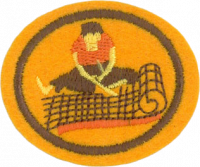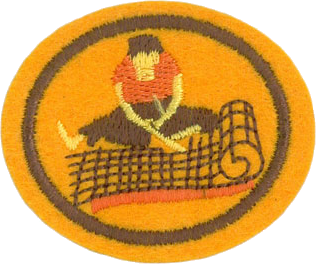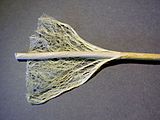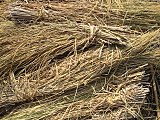Difference between revisions of "AY Honors/Mat Making/Answer Key"
m (Transwiki:Coir moved to AY Honor Mat Making: Transwiki merge of w:Coir -> AY Honor Mat Making) |
m (- Category of AYHAB) |
||
| (46 intermediate revisions by 5 users not shown) | |||
| Line 1: | Line 1: | ||
| − | + | {{HonorSubpage}} | |
| + | <section begin="Body" /> | ||
| + | {{ansreq|page={{#titleparts:{{PAGENAME}}|2|1}}|num=1}} | ||
| + | <noinclude><translate><!--T:40--> | ||
| + | </noinclude> | ||
| + | <!-- 1. In your culture name the materials which are used in mat making. --> | ||
| + | <gallery perrow=3 widths=200px> | ||
| + | Image:Singapore coconut.jpg|<center>Coconut</center> | ||
| + | Image:Bulrush Soos 01.JPG|<center>Bulrush</center> | ||
| + | Image:Hanfstengel.jpg|<center>Hemp</center> | ||
| + | Image:Rice straw.jpg|<center>Straw</center> | ||
| + | Image:Phoenix dactylifera2.jpg|<center>Date palm</center> | ||
| + | Image:Pandanus dsc03667.jpg|<center>Screw pine</center> | ||
| + | </gallery> | ||
| + | Mats are made of many, many different types of material, including: | ||
| + | * Coir (coconut fibers) | ||
| + | * Reeds | ||
| + | * Bulrushes (including cattails) | ||
| + | * Hemp | ||
| + | * Rattan (cane) | ||
| + | * Various grasses | ||
| + | * Straw | ||
| + | * Palm leaves | ||
| + | * Screw pine (Pandanus) leaves | ||
| − | == | + | <!--T:41--> |
| − | + | <noinclude></translate></noinclude> | |
| + | {{CloseReq}} <!-- 1 --> | ||
| + | {{ansreq|page={{#titleparts:{{PAGENAME}}|2|1}}|num=2}} | ||
| + | <noinclude><translate></noinclude> | ||
| + | <!-- 2. Explain and demonstrate how to prepare this material. --> | ||
| + | ===Coir=== <!--T:42--> | ||
| + | Green coconuts, harvested after about six to twelve months on the plant, contain pliable white fibres. Brown fibre is obtained by harvesting fully mature coconuts when the nutritious layer surrounding the seed is ready to be processed into copra and desiccated coconut. The fibrous layer of the fruit is then separated from the hard shell (manually) by driving the fruit down onto a spike to split it (''De-husking''). A well seasoned husker can manually separate 2,000 coconuts per day. Machines are now available which crush the whole fruit to give the loose fibres. These machines can de-husk up to 2,000 coconuts per hour. | ||
| − | The coir | + | <!--T:4--> |
| + | ;Brown fibre: | ||
| + | The fibrous husks are soaked in pits or in nets in a slow moving body of water to swell and soften the fibres. The long bristle fibres are separated from the shorter mattress fibres underneath the skin of the nut, a process known as ''wet-milling''. The mattress fibres are sifted to remove dirt and other rubbish, dried in the sun and packed into bales. Some mattress fibre is allowed to retain more moisture so that it retains its elasticity for 'twisted' fibre production. The coir fibre is elastic enough to twist without breaking and it holds a curl as though permanently waved. Twisting is done by simply making a rope of the hank of fibre and twisting it using a machine or by hand. The longer bristle fibre is washed in clean water and then dried before being tied into bundles or hunks. It may then be cleaned and 'hackled' by steel combs to straighten the fibres and remove any shorter fibre pieces. Coir bristle fibre can also be bleached and dyed to obtain hanks of different colours. | ||
| + | |||
| + | <!--T:5--> | ||
| + | ;White fibre: | ||
| + | The immature husks are suspended in a river or water-filled pit for up to ten months. During this time micro-organisms break down the plant tissues surrounding the fibres to loosen them — a process known as ''retting''. Segments of the husk are then beaten by hand to separate out the long fibres which are subsequently dried and cleaned. Cleaned fibre is ready for spinning into yarn using a simple one-handed system or a spinning wheel. | ||
| + | |||
| + | ===Reeds, Bullrushes, and Grass=== <!--T:6--> | ||
| + | |||
| + | <!--T:28--> | ||
| + | This is pretty simple and low tech. Remove foreign material. Cut off any roots, and trim to uniform lengths. Some material works best when dried before weaving. | ||
| + | |||
| + | ===Hemp=== <!--T:29--> | ||
| + | |||
| + | <!--T:7--> | ||
| + | Hemp fiber is highly valued because the primary bast fibers in the bark are 5–40 mm long, and can be amalgamated in fiber bundles which can be 1–5 m long (secondary bast fibers are about 2 mm long). | ||
| + | |||
| + | <!--T:8--> | ||
| + | The most desirable (“long”) fibers are found in the phloem-associated tissues external to the phloem, just under the “bark.” The first step in fiber extraction is to ret (“rot”) away the softer parts of the plant. You need to expose the cut stems to microbial decay in the field or by submerging in water. Either plan gets the woody core separated from the useful fiber. | ||
| + | |||
| + | <!--T:30--> | ||
| + | Water retting in ditches causes pollution and is very labor intensive, so it has been abandoned in more developed countries. However, most hemp fiber used in textiles today is water retted in China and Hungary. The use of tanks of water for retting in tanks rather than in open water controls the effluents while providing high-quality fiber. Science is developing improved microorganisms and enzymes that could augment or replace traditional water retting. | ||
| + | |||
| + | <!--T:31--> | ||
| + | Better equipment and new technologies may allow commercially viable fine textile production in western Europe and North America, but China is still likely to control the hemp cloth market for the foreseeable future. | ||
| + | |||
| + | <!--T:32--> | ||
| + | Specialized harvesting, processing, spinning and weaving equipment are required for preparing fine hemp textiles in quantity. | ||
| + | |||
| + | ===Rattan=== <!--T:9--> | ||
| + | Generally, raw rattan is processed into several products to be used as materials in furniture making. The various species of rattan ranges from several millimetres up to 5-7 cm in diameter. From a strand of rattan, the skin is usually peeled off, to be used as rattan weaving material. | ||
| + | |||
| + | ===Straw=== <!--T:10--> | ||
| + | According to some research straw mats are best made from damp straw. | ||
| + | |||
| + | ===Palm leaves=== <!--T:33--> | ||
| + | Typically younger leaves were best for basket making. They were left in the sun to cure before use. | ||
| + | |||
| + | ===Screw pine=== <!--T:34--> | ||
| + | Dry the leaves first in the sun before weaving with them. | ||
| + | |||
| + | <!--T:43--> | ||
| + | <noinclude></translate></noinclude> | ||
| + | {{CloseReq}} <!-- 2 --> | ||
| + | {{ansreq|page={{#titleparts:{{PAGENAME}}|2|1}}|num=3}} | ||
| + | <noinclude><translate><!--T:44--> | ||
| + | </noinclude> | ||
| + | <!-- 3. Name plants that can be used for making dyes in your culture. Tell where they come from and how to prepare them for dying. --> | ||
| − | + | <!--T:11--> | |
| − | + | There are many thousands of different plants that can be used for dying, including ones you can find in your own back yard or local forest. Roots, nuts, bark, and flowers are all common sources of dye. Take a look at [http://pioneerthinking.com/crafts/natural-dyes this list] for plants sorted by color and the source of these directions. This worldwide wiki can't tell you which plants are in YOUR culture, but with a little research you will know. | |
| − | |||
| − | === | + | <!--T:12--> |
| − | + | Here are some generalized directions that should work with most plants. Variation may be required for specific plants, and different cultures may do things somewhat differently. This assumes you will either dye the material before weaving or dye the entire finished mat at once. There are two main jobs - prepare the material and make the dye. | |
| + | |||
| + | ===Preparing the Mat Material for Dyeing=== <!--T:13--> | ||
| + | |||
| + | <!--T:14--> | ||
| + | You will likely need to prepare a simple Color Fixative: | ||
| + | |||
| + | <!--T:15--> | ||
| + | a) Salt Fixative (for berry dyes) 1/2 cup salt to 8 cups cold water | ||
| + | |||
| + | <!--T:16--> | ||
| + | b) Plant Fixatives (for plant dyes) 4 parts cold water to 1 part vinegar | ||
| + | |||
| + | <!--T:17--> | ||
| + | Add material to be died to the fixative and simmer for an hour. Rinse the material and squeeze out excess. Rinse in cool water until water runs clear. | ||
| + | |||
| + | ===Preparing the Plants=== <!--T:18--> | ||
| − | + | <!--T:19--> | |
| − | + | Step 1: Gather the plant material: blossoms should be in full bloom, berries ripe and nuts mature for best results | |
| − | + | <!--T:20--> | |
| − | + | Step 2: Next chop your plant material into small pieces and put it in a suitable pot. Add twice as much water to your plant material. Bring to a boil, then simmer for about an hour. Next strain the plant material out. A time saver is to put the chopped plant material in a net bag, just pull the bag instead of straining. | |
| − | |||
| − | + | <!--T:21--> | |
| + | Here is one example to follow in your report. | ||
| − | + | ====Rattan==== <!--T:22--> | |
| + | The fruit of some rattans exudes a red resin called dragon's blood. This resin was used as a dye for violins, among other things. The resin normally results in a wood with a light peach hue. | ||
| − | + | <!--T:23--> | |
| − | + | Dragon's blood resin is produced from the rattan palms of the genus ''Daemonorops'' of the Indonesian islands and known there as ''jerang'' or ''djerang''. It is gathered by breaking off the layer of red resin encasing the unripe fruit of the rattan. The collected resin is then rolled into solid balls before being sold. | |
| − | + | <!--T:45--> | |
| − | + | <noinclude></translate></noinclude> | |
| + | {{CloseReq}} <!-- 3 --> | ||
| + | {{ansreq|page={{#titleparts:{{PAGENAME}}|2|1}}|num=4}} | ||
| + | <noinclude><translate></noinclude> | ||
| + | <!-- 4. Show how to use native and synthetic dyes in dyeing mat making material. --> | ||
| + | ===Using Natural Dyes=== <!--T:46--> | ||
| + | {{:AY Honors/Natural dyes}} | ||
| + | ===Using Synthetic Dyes=== | ||
| + | Synthetic dyes are created by chemical companies and are readily available for purchase in every possible color. Lack of raw material, over harvesting, and lack of time may make natural dyes hard to get and use. The downside is that synthetic dyes exposure may be harmful to health, are not "traditional" thus not fitting in with the handmade mat, and may produce more uniform and therefore less appealing colors. | ||
| − | + | <!--T:36--> | |
| − | + | Follow the manufacturer's directions, or those of your instructor. | |
| − | |||
| − | == | + | <!--T:47--> |
| − | + | <noinclude></translate></noinclude> | |
| − | + | {{CloseReq}} <!-- 4 --> | |
| + | {{ansreq|page={{#titleparts:{{PAGENAME}}|2|1}}|num=5}} | ||
| + | <noinclude><translate><!--T:48--> | ||
| + | </noinclude> | ||
| + | <!-- 5. Make two mats showing two different types of weaving. One of the mats must have a reasonably fine weave. --> | ||
| − | + | <!--T:26--> | |
| − | <!-- | + | This is where you show what you learned and end up with two mats you can use or give as gifts. |
| − | |||
| − | + | <!--T:37--> | |
| − | + | Nearly every culture makes mats for sitting or walking on, drying food, decoration, as place mats and so forth. Ideally you will follow the procedures and use materials traditionally used in your local area. In North America look into how the natives made mats traditionally. | |
| − | |||
| − | + | <!--T:38--> | |
| + | A good clear video [https://www.youtube.com/watch?v=JmBQNGHZQAk weaving a mat with cat tails]. | ||
| − | + | <!--T:49--> | |
| − | + | <noinclude></translate></noinclude> | |
| − | + | {{CloseReq}} <!-- 5 --> | |
| − | + | <noinclude><translate></noinclude> | |
| − | + | ==References== <!--T:27--> | |
| − | + | #http://www.hort.purdue.edu/newcrop/ncnu02/v5-284.html | |
| − | + | #http://www.guampedia.com/weaving/ | |
| + | <noinclude></translate></noinclude> | ||
| + | {{CloseHonorPage}} | ||
Latest revision as of 16:03, 14 July 2022
1
Mats are made of many, many different types of material, including:
- Coir (coconut fibers)
- Reeds
- Bulrushes (including cattails)
- Hemp
- Rattan (cane)
- Various grasses
- Straw
- Palm leaves
- Screw pine (Pandanus) leaves
2
Coir
Green coconuts, harvested after about six to twelve months on the plant, contain pliable white fibres. Brown fibre is obtained by harvesting fully mature coconuts when the nutritious layer surrounding the seed is ready to be processed into copra and desiccated coconut. The fibrous layer of the fruit is then separated from the hard shell (manually) by driving the fruit down onto a spike to split it (De-husking). A well seasoned husker can manually separate 2,000 coconuts per day. Machines are now available which crush the whole fruit to give the loose fibres. These machines can de-husk up to 2,000 coconuts per hour.
- Brown fibre
The fibrous husks are soaked in pits or in nets in a slow moving body of water to swell and soften the fibres. The long bristle fibres are separated from the shorter mattress fibres underneath the skin of the nut, a process known as wet-milling. The mattress fibres are sifted to remove dirt and other rubbish, dried in the sun and packed into bales. Some mattress fibre is allowed to retain more moisture so that it retains its elasticity for 'twisted' fibre production. The coir fibre is elastic enough to twist without breaking and it holds a curl as though permanently waved. Twisting is done by simply making a rope of the hank of fibre and twisting it using a machine or by hand. The longer bristle fibre is washed in clean water and then dried before being tied into bundles or hunks. It may then be cleaned and 'hackled' by steel combs to straighten the fibres and remove any shorter fibre pieces. Coir bristle fibre can also be bleached and dyed to obtain hanks of different colours.
- White fibre
The immature husks are suspended in a river or water-filled pit for up to ten months. During this time micro-organisms break down the plant tissues surrounding the fibres to loosen them — a process known as retting. Segments of the husk are then beaten by hand to separate out the long fibres which are subsequently dried and cleaned. Cleaned fibre is ready for spinning into yarn using a simple one-handed system or a spinning wheel.
Reeds, Bullrushes, and Grass
This is pretty simple and low tech. Remove foreign material. Cut off any roots, and trim to uniform lengths. Some material works best when dried before weaving.
Hemp
Hemp fiber is highly valued because the primary bast fibers in the bark are 5–40 mm long, and can be amalgamated in fiber bundles which can be 1–5 m long (secondary bast fibers are about 2 mm long).
The most desirable (“long”) fibers are found in the phloem-associated tissues external to the phloem, just under the “bark.” The first step in fiber extraction is to ret (“rot”) away the softer parts of the plant. You need to expose the cut stems to microbial decay in the field or by submerging in water. Either plan gets the woody core separated from the useful fiber.
Water retting in ditches causes pollution and is very labor intensive, so it has been abandoned in more developed countries. However, most hemp fiber used in textiles today is water retted in China and Hungary. The use of tanks of water for retting in tanks rather than in open water controls the effluents while providing high-quality fiber. Science is developing improved microorganisms and enzymes that could augment or replace traditional water retting.
Better equipment and new technologies may allow commercially viable fine textile production in western Europe and North America, but China is still likely to control the hemp cloth market for the foreseeable future.
Specialized harvesting, processing, spinning and weaving equipment are required for preparing fine hemp textiles in quantity.
Rattan
Generally, raw rattan is processed into several products to be used as materials in furniture making. The various species of rattan ranges from several millimetres up to 5-7 cm in diameter. From a strand of rattan, the skin is usually peeled off, to be used as rattan weaving material.
Straw
According to some research straw mats are best made from damp straw.
Palm leaves
Typically younger leaves were best for basket making. They were left in the sun to cure before use.
Screw pine
Dry the leaves first in the sun before weaving with them.
3
There are many thousands of different plants that can be used for dying, including ones you can find in your own back yard or local forest. Roots, nuts, bark, and flowers are all common sources of dye. Take a look at this list for plants sorted by color and the source of these directions. This worldwide wiki can't tell you which plants are in YOUR culture, but with a little research you will know.
Here are some generalized directions that should work with most plants. Variation may be required for specific plants, and different cultures may do things somewhat differently. This assumes you will either dye the material before weaving or dye the entire finished mat at once. There are two main jobs - prepare the material and make the dye.
Preparing the Mat Material for Dyeing
You will likely need to prepare a simple Color Fixative:
a) Salt Fixative (for berry dyes) 1/2 cup salt to 8 cups cold water
b) Plant Fixatives (for plant dyes) 4 parts cold water to 1 part vinegar
Add material to be died to the fixative and simmer for an hour. Rinse the material and squeeze out excess. Rinse in cool water until water runs clear.
Preparing the Plants
Step 1: Gather the plant material: blossoms should be in full bloom, berries ripe and nuts mature for best results
Step 2: Next chop your plant material into small pieces and put it in a suitable pot. Add twice as much water to your plant material. Bring to a boil, then simmer for about an hour. Next strain the plant material out. A time saver is to put the chopped plant material in a net bag, just pull the bag instead of straining.
Here is one example to follow in your report.
Rattan
The fruit of some rattans exudes a red resin called dragon's blood. This resin was used as a dye for violins, among other things. The resin normally results in a wood with a light peach hue.
Dragon's blood resin is produced from the rattan palms of the genus Daemonorops of the Indonesian islands and known there as jerang or djerang. It is gathered by breaking off the layer of red resin encasing the unripe fruit of the rattan. The collected resin is then rolled into solid balls before being sold.
4
Using Natural Dyes
Gather your plants from an area where the species you are after is abundant. Be sure to not take more than two-thirds of the plants from any one area. Natural fabrics work best with natural dyes, so choose cotton or wool (you can use yarn if you like).
The amount of material needed for the dyepot varies. For four ounces of cloth or yarn, use 12 ounces of plant material, one ounce of alum, and 1/4 ounce of cream of tartar in four quarts of water. Soak skeins of white yarn or material in plain water for 24 hours before dyeing.
Create Dye
- Put water in a large pot, add shredded plant parts (place in net bag)
- Simmer 1/2 to 1 hour (just below the boiling point)
- Strain out material (remove net bag)
Dye Fibers
- Add alum and cream of tartar to water and stir (cream of tartar helps keep fibers soft)
- Put in pre-moistened fiber/yarn
- Simmer until material is a little darker than you desire, stirring and submerging occasionally
- Remove from heat
Remove Fibers from Bath and Dry
- Rinse (starting with warm water) until cool
- Hang to dry
Be sure to wash the cloth by itself the first time you launder it. The last thing you want to do is accidentally dye your other clothes!
Using Synthetic Dyes
Synthetic dyes are created by chemical companies and are readily available for purchase in every possible color. Lack of raw material, over harvesting, and lack of time may make natural dyes hard to get and use. The downside is that synthetic dyes exposure may be harmful to health, are not "traditional" thus not fitting in with the handmade mat, and may produce more uniform and therefore less appealing colors.
Follow the manufacturer's directions, or those of your instructor.
5
This is where you show what you learned and end up with two mats you can use or give as gifts.
Nearly every culture makes mats for sitting or walking on, drying food, decoration, as place mats and so forth. Ideally you will follow the procedures and use materials traditionally used in your local area. In North America look into how the natives made mats traditionally.
A good clear video weaving a mat with cat tails.








